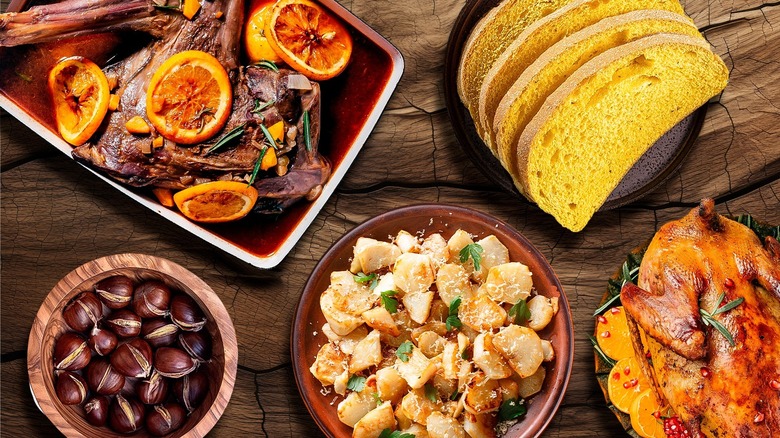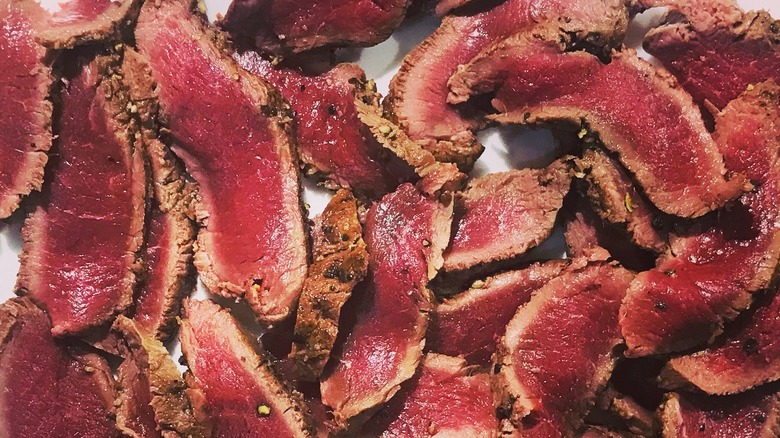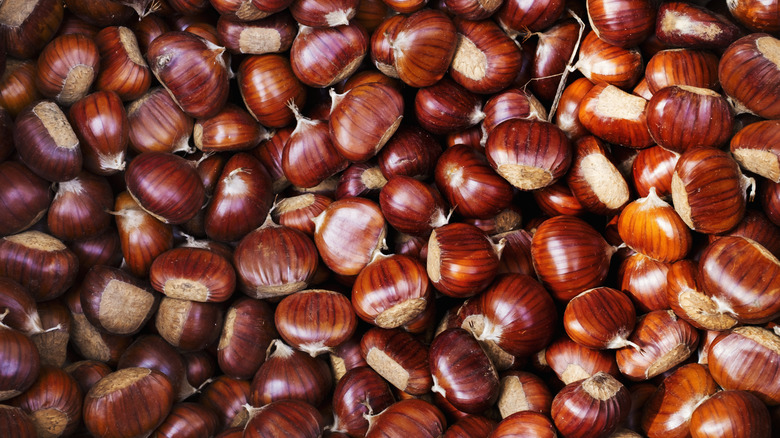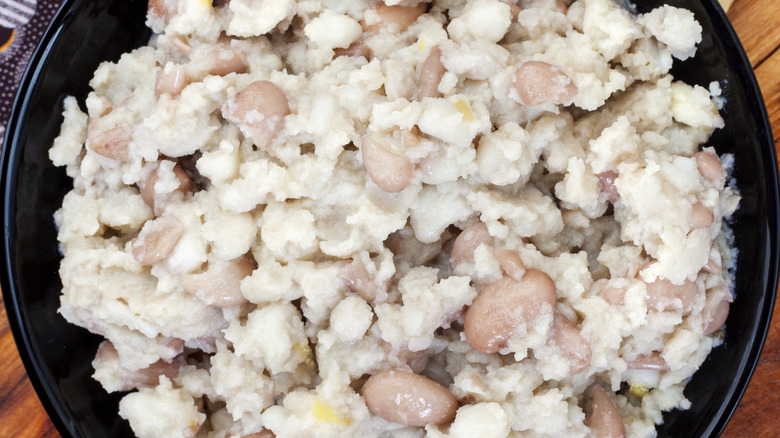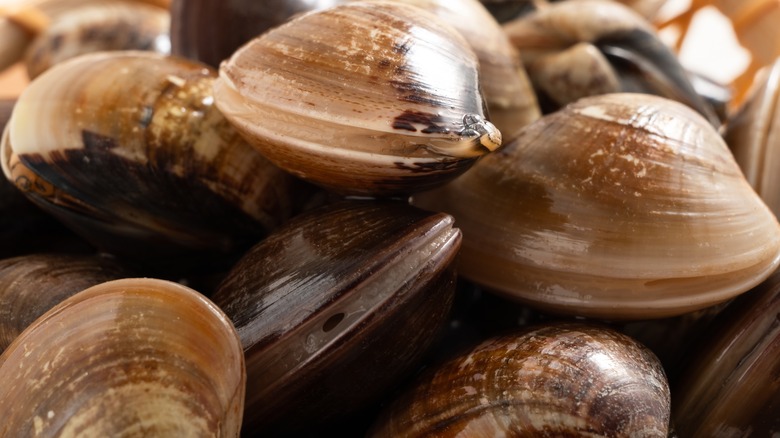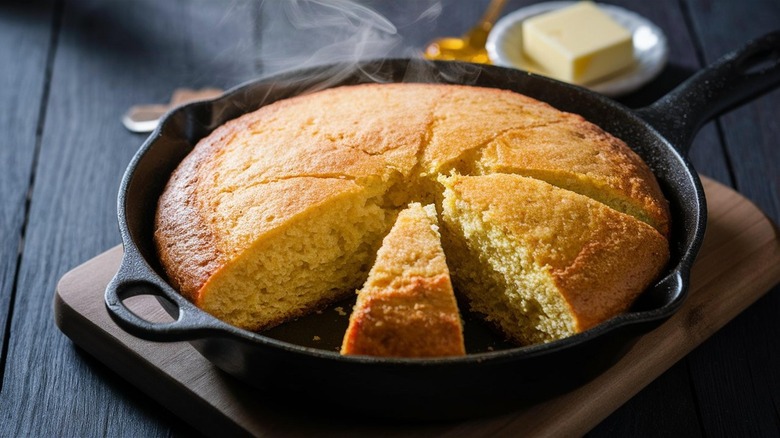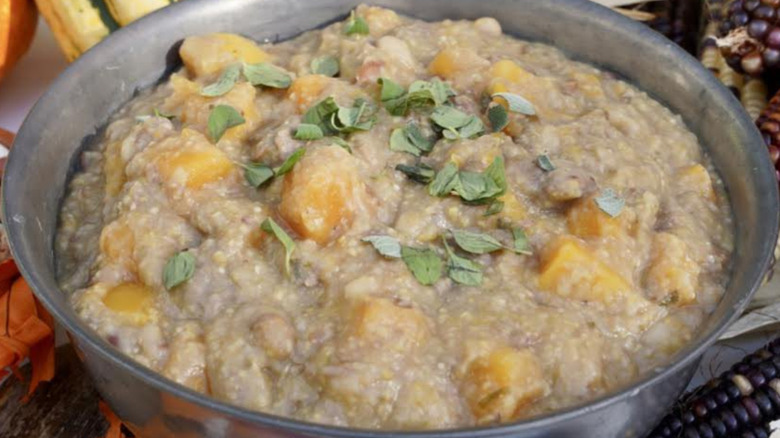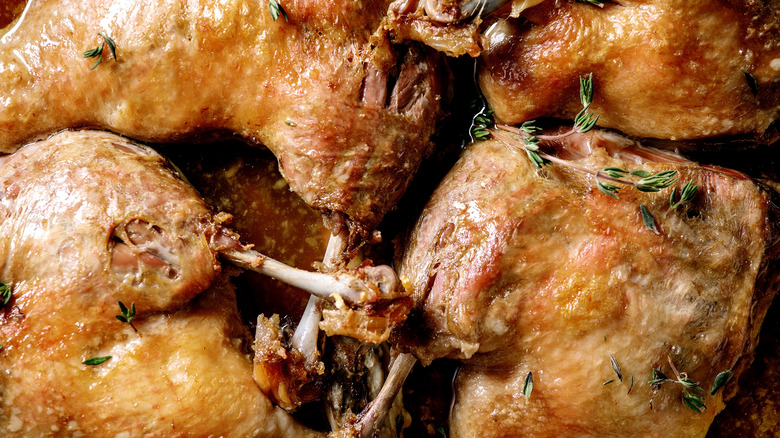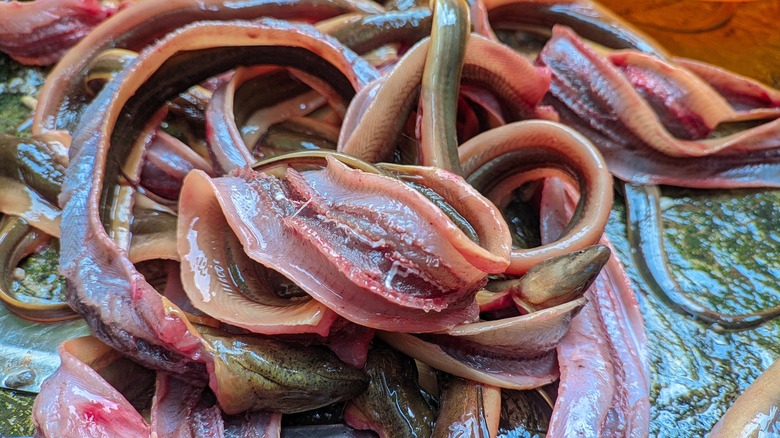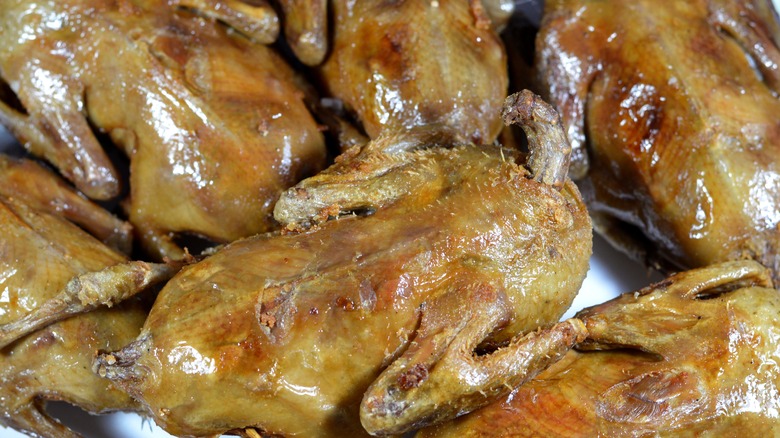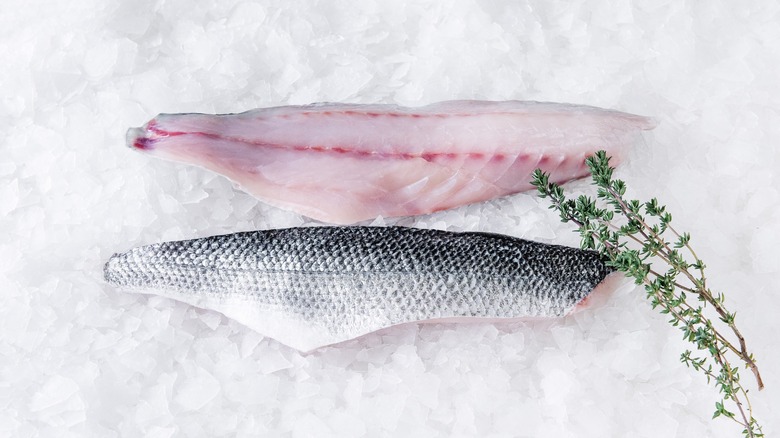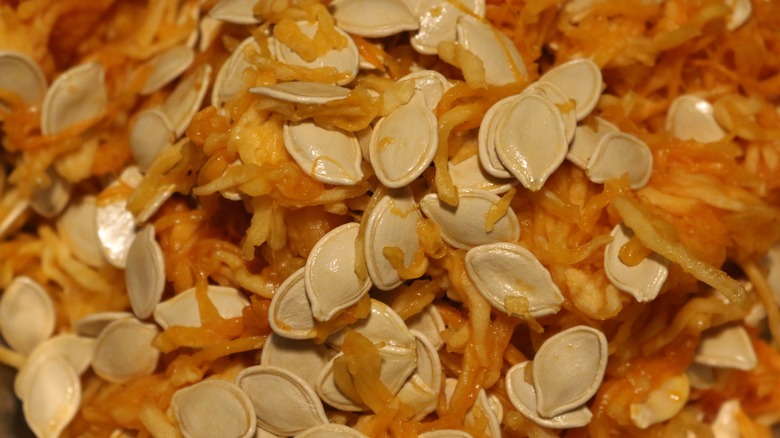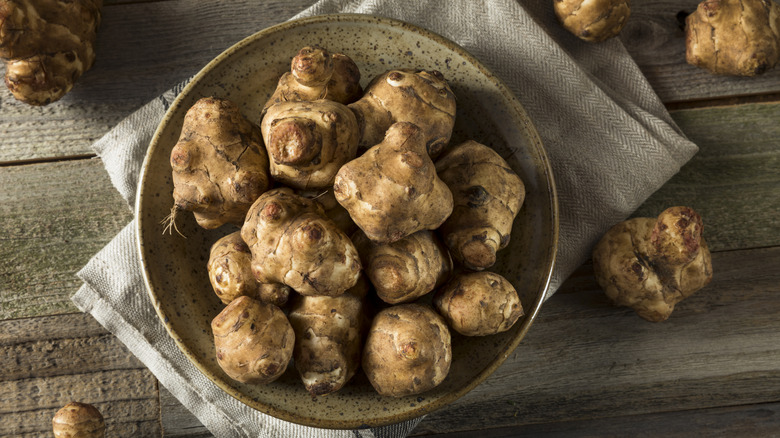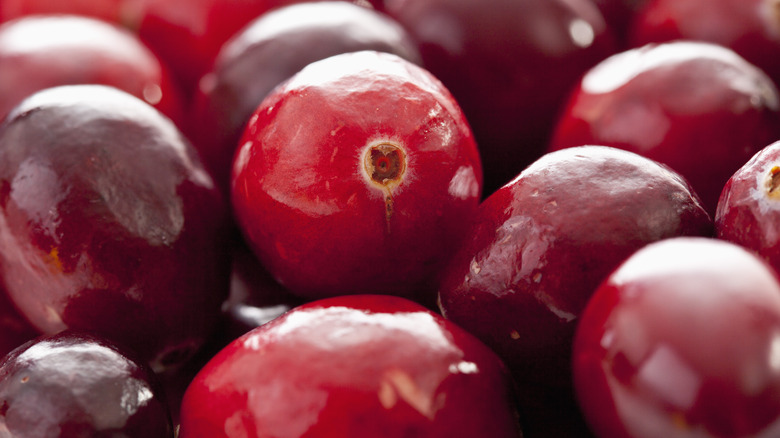13 Foods That Were Surprisingly Eaten At The First Thanksgiving
We may receive a commission on purchases made from links.
What many of us learn as children about the first Thanksgiving isn't the most accurate depiction of how that historic meal really went down. The autumnal feast, held in 1621, was indeed a celebration of the Plymouth settlers' first successful harvest. But the part where a pilgrim carved a turkey and shared it with a group of shirtless Native Americans? It's a stretch. The foods they actually ate were different from a modern Thanksgiving spread. Turkey wasn't the star — if it was there at all. As for the Native Americans' attire, it was fall in Massachusetts so they were probably more covered up.
One of the only surviving accounts of the first Thanksgiving is a letter written by Edward Winslow. It describes some of what was eaten and who was there. By then, nearly half of the colonists who sailed to Plymouth Rock in 1620 had died. Wampanoag society members indigenous to the region taught the remaining settlers how to farm the land and where to hunt and fish — essentially saving their lives. The tradition of giving thanks to the bounties of nature with a celebratory meal was a practice both cultures shared.
The first Thanksgiving lasted three days and was not an annual tradition (yet). Wampanoag leader Massasoit Ousamequin was there, as was Tisquantum (whom the settlers called Squanto). Tisquantum's knowledge of the English language (he learned while enslaved in Europe), had been critical to the colonists' survival. There were no forks, but there was plenty of seafood and sides.
1. Venison
Edward Winslow's December 1621 letter that mentions the first Thanksgiving gathering doesn't offer up a ton of specifics about what was served that day, but one thing he made certain was that the Native Americans brought five deer to the meal. Historians surmise that the colonists didn't invite any Wampanoag members to share in their Thanksgiving bounty. Around 90 Wampanoag warriors headed for Plymouth when they heard gunfire, presuming it was an oncoming attack from the settlers. Once they realized the shots were fired in jubilant honor of the feast, the Wampanoags killed five deer as an offering.
The Wampanoag, a Native American society consisting of numerous tribes, had immense respect for deer. When they hunted deer, no part of the animal went to waste. The meat was eaten, while the bones were fashioned into tools or jewelry, and the skin and fur made into clothing. The venison eaten on the first Thanksgiving was likely fire-roasted on a spit, but since there were five deer, a portion of the meat was probably used another way.
Native Americans incorporate venison into stews and the Thanksgiving feast would have been a good opportunity to make that happen. The colonists were known to enjoy venison, a type of meat they almost certainly never tried before coming to Plymouth. In 17th century England, it was against the law to buy or sell venison commercially, so British commoners (which is what colonists were) had no exposure to it.
2. American chestnuts
The greatest commonality between the first Thanksgiving and the annual holiday we enjoy in modern times is that the menu centers around seasonal foods, many with regional ties. This is exactly how the settlers and Native Americans ate. American chestnuts fit right into this way of eating. Nowadays, chestnuts are more associated with Christmastime, but it's likely that they featured at the original Thanksgiving meal.
Like many of the foods eaten at the first Thanksgiving, American chestnuts were probably prepared multiple ways for the occasion. Ground chestnuts, along with walnuts, beechnuts, and acorns commonly served as thickeners in stew, or sobaheg, in the Wampanoag language. Another possibility is that chestnuts were used for stuffing inside roasted birds. An existing 17th-century recipe for goose stuffing consists of shelled chestnuts. American chestnuts were also enjoyed on their own, harvested from trees in autumn and roasted over a fire.
If you tried to recreate the first Thanksgiving feast today, American chestnuts would not be part of it. In 1904, a non-native chestnut blight fungus infected American forests and by 1950, it had killed off almost every homegrown chestnut tree in existence. The American chestnut tree was never restored to its former glory, and is considered a functionally extinct plant species.
3. Samp
Starchy sides are pretty much non-negotiable on the Thanksgiving table these days, and as it turns out, those present at the first Thanksgiving felt the same way. Potatoes weren't available in Plymouth then, but there was samp, and it was most likely eaten at the 1621 harvest celebration. The word samp comes from "nasaump," the Narragansett word for hominy. Samp is a soft corn porridge and it's still popular in parts of the world today.
Hominy in Plymouth was sourced from a multi-colored maize called flint, which the settlers referred to as "Indian corn." The Wampanoag people ground up the kernels with a smooth rock to produce corn meal, which was cooked to make samp. Other methods of preparation involved soaking the kernels in water and ash to remove the hulls, then slow-cooking them until they became soft. North American settlers in the 1600s often enjoyed samp mixed with milk. Today, samp is still eaten in and around Native American reservations. It is also popular in South Africa, where it is traditionally served as samp and beans.
4. Shellfish
The geographical landscape of Plymouth (or Plimoth Plantation as the settlers called it in 1621), was a direct link to the foods that were eaten at the first Thanksgiving. Plymouth's coastal location overlooking Cape Cod Bay offered a multitude of shellfish to those who inhabited the area. Mussels, lobster, and clams were plentiful in the bay's waters and almost certainly made it to the feasting table.
Centuries ago, lobsters were so abundant in Cape Cod Bay they would wash up on the shore in piles two feet high. This made the crustaceans easy to gather by hand. Wampanoag women were typically responsible for gathering shellfish. Edward Winslow's letter that mentions the first Thanksgiving also describes the large quantities of lobster and mussels available to the settlers, and that mussels in particular were plentiful in the colder months.
Many of the foods the Plymouth settlers encountered were foreign to them. In order to prepare what they ate in a way that was palatable and left nothing to waste, they relied on the vast knowledge of the Wampanoag natives. Shellfish was no exception. The Wampanoag taught the settlers how to dry and smoke what was caught. The method of wrapping shellfish in seaweed and cooking them over hot rocks is said to have inspired the New England clambakes people know and love today. Native Americans also used lobster scraps as bait to catch bigger fish and understood that their shells made great fertilizer for crops.
5. Cornbread
Unleavened bread was the order of the day at the first Thanksgiving. Cornbread was a clear choice for the 1621 feast — no yeast was required, there was plenty of corn around, and it's delicious. For Plymouth settlers, cornbread, or "maizium" as it was also known, was yet another influence from the Wampanoag diet. Colonists in the New World documented their suspicions of Indigenous foods well before Plymouth was established, however, cornbread appears to have been one of the foods settlers embraced. In William J. Miller's "Notes concerning the Wampanoag tribe of Indians," he describes the taste of maizium as "kind."
In fact, the settlers had taken kindly enough to maize that according to Edward Winslow's letter, they'd planted 20 acres of it in the spring. The cornbread of today is made with milk and eggs, but there's a good chance that the settlers adopted the Native American recipe, which was more simple. Boiled cornmeal mixed with water and maybe salt would be baked in a hearth or over an open fire. Another cornbread variation might also have been present at the first Thanksgiving. A cornmeal flatbread known as sop or sippit was also something the settlers made, which they would cover with meat drippings before eating.
6. Sobaheg
As the weather turns colder, making a hearty batch of stew is a great way to incorporate numerous seasonal ingredients in one dish — plus it feeds a crowd. "Sobaheg" means stew in the Wampanoag language, and there's a good chance it was served as part of the first Thanksgiving meal. A traditional autumn sobaheg contains a mixture of cooked beans, corn, squash, and nuts, all seasoned with salt. The rest of the ingredients in sobaheg are very customizable.
Many Wampanoag recipes call for venison or other game, and since we know that they brought five freshly killed deer to the first Thanksgiving, it's probable that some of that meat went into the sobaheg. Other versions of the recipe include poultry or shellfish and clam juice. Dried berries and sunflower seeds may have also been thrown in. Although it's been more than 400 years since the first Thanksgiving, native tribes of the Wampanoag society continue to uphold the culinary traditions of the past. Members of the Wampanoag tribal society still reside in New England today, and many of them eat sobaheg.
7. Waterfowl
If you walked into your family Thanksgiving gathering and saw a platter of roast swan on the table, you might feel a little weird about it. We wouldn't blame you since swan hunting is illegal in 41 states and the U.K. The settlers would be ready to dig in though, and probably did on the first Thanksgiving. Historical manuscripts from Plimoth Plantation provide evidence that the early settlers hunted various types of waterfowl, including ducks, geese, and yes, even swans. The Wampanoag society members were skilled hunters who taught the settlers how to make good use of the land's many natural gifts — and they likely ate swans, too.
To cook larger birds, the settlers would use a combination of boiling and fire-roasting. As for stuffing, chunks of onions and herbs were likely the combination of choice. Onion and herb stuffing added flavor and texture. Both the settlers and Wampanoag people were known to grow various green herbs and onions. Stuffing containing tree nuts, like shelled chestnuts, were used in the 17th century as well. As for the fate of swan suppers in the New World? By the late 1630s, historical records show that the settlers weren't really digging the taste anymore, and the elegant water bird was spared from future Thanksgiving day tables.
8. Eel
Eels are a little creepy, but once you get past that, you'll find that they are quite tasty. After damp, disease, and starvation wiped out almost half of the Mayflower's passengers (only four women survived the first winter), those that survived were in no position to be put off by some slithering eels (jellied eels would have their moment in 18th-century working class London). One of the first food offerings Tisquantum — the English-speaking member of the Patuxet tribe — brought to the colonists was an armful of eels. He had caught them at the river with his bare feet and hands.
The settlers were all about the sweet, rich taste of eel and learned from Tisquantum how and where to catch more. Edward Winslow's letter described procuring eels from the river, saying, "In September we can take a hogshead of eels in a night, with small labor, and can dig them out of their beds ... ." The settlers' enthusiasm over eels makes their place at the first Thanksgiving feast a near certainty. It was likely access to a wider range of foods, including dairy and chicken, and a general inclination toward a more Westernized palate that killed eels' rightful place on the Thanksgiving table. It might be time to bring it back.
9. Pigeon
Geese, duck, and swan satiated the roughly 140 attendees of the first Thanksgiving, but that doesn't mean that petite fowl like pigeons were excluded. Edward Winslow's writing of the first Thanksgiving gives some telling information about the colonists' preparation for the three-day feast. "Our governor sent four men on fowling, that so we might after a more special manner rejoice together, after we had gathered the fruit of our labors; they four in one day killed as much fowl ... served the company almost a week ... ." With enough fowl to last the settlers a week, it's safe to say that pigeons were part of the haul.
Plymouth was densely populated with passenger pigeons in the 1600s. A flock of them could be heard up to 15 minutes before they appeared overhead, and a group of men shooting at them in flight could kill as many as 200. Circa 1621, pigeons were most likely spit-roasted before serving. Later on, pigeon pies were popular among colonists, and often contained a mixture of pigeon and other meats inside a puff pastry.
Another wild bird that might have been part of the festivities was turkey. Historians deduce that the wild turkeys roaming around Plymouth were tough and gamey — unsuitable for a table centerpiece. If they were served, they along with pigeons, were more of a side dish. While turkey graduated to a starring Thanksgiving role, passenger pigeons suffered a tragic fate. By 1914, the unique birds were hunted to extinction.
10. Cod and bass
Cape Cod is named as such for a reason, and the settlers soon learned that the Atlantic was teeming with them. Edward Winslow wrote of fresh cod in the summer in his 1621 letter to home, so he and his fellow settlers definitely ate them. It's uncertain whether the settlers also caught cod in autumn to prepare for Thanksgiving, or had dried cod available. Either way, it was a staple protein of their diet in Plimoth Plantation's early days, and very well could have featured at Thanksgiving's debut spread.
Another fish the settlers had access to was bass. William Bradford, who was Plymouth's first governor wrote retrospectively of the great number of striped bass, along with cod and other fish that swam in the coastal waters, enough to feed the whole settlement. The prevalence of bass, also known as stripers, helped sustain the colonists' survival after a harrowing winter filled with death and despair, and surely could have fed settlers and Wampanoag alike on the first Thanksgiving.
11. Pumpkin — without the pie
Following the lead of the Indigenous people of the "New World," the colonial women of Plymouth kept gardens where they cultivated various vegetables and herbs. Among the selection were root vegetables, leafy greens, beans, and different types of squash, which the settlers referred to as pompion. It would be a while before pumpkin pie became a Thanksgiving Day staple, but pumpkin in simpler form probably made an appearance at the first Thanksgiving.
Food historians suggest that stewed pumpkin dishes were eaten by colonists in 17th-century New England. The colonists learned how to grow and prepare pumpkins from the Wampanoag people, who harvested them long before the settlers arrived. The Native Americans also recognized the tastiness of pumpkin seeds and may have been privy to certain health benefits associated with pumpkin.
In those days, pumpkins were often cooked over hot coals for as long as a day before they were eaten. The settlers may have brought spices with them when they set sea on the Mayflower, as other ships making the journey to America in that time period had done. Spices they may have access to include cinnamon, ginger, and nutmeg — all of which would have given some lovely flavor enhancement to pumpkin.
12. Sunchokes and garlic
A later season meant that sunchokes (also known as Jerusalem artichokes) and garlic were plentiful for the autumn festivities. Sunchokes and garlic grew wild in the Plymouth region and could be foraged as accompaniments to what was undoubtedly a very meat-heavy array of foods. Luckily, the day-long feast also included some physical activity, as noted in Edward Winslow's letter — quite a contrast from the turkey-coma football watching that follows many a modern Thanksgiving meal.
Sunchokes are the perennial, hardy roots of a plant that is part of the sunflower family. The portion of root that remains underground can survive during the winter months and reappear after the frost has subsided. Similar to other vegetables eaten by settlers in those days, sunchokes and garlic bulbs were typically boiled and added to sobaheg (aka stew). Although garlic grew naturally in the wild, it has been suggested that settlers took to growing garlic in their home gardens alongside onions, herbs, and root vegetables.
13. Cranberries, though not as a sauce
Thanksgiving without cranberry sauce seems unheard of, yet those who partook in the first Thanksgiving had no idea how ubiquitous the jellied fruit would become. They were well aware of cranberries though, and regularly skimmed the tart fruit off of Massachusetts bogs. Wampanoag tribes were known to eat cranberries raw, and understood the value in drying them once their season ended. Spices and seasonings weren't commonplace in those days, and throwing cranberries into a dish lent a punchy tartness to foods that might otherwise be mushy and bland.
It's probable that cranberries were utilized at the first Thanksgiving. Although the local cranberry bogs were miles away from the Plymouth settlement, it's not outlandish to think that the settlers would have dried ones on hand for the feast. Cranberries were new to the settler's plates, as were the multitude of ways they could be used in food. One innovative offering inspired by the Wampanoag diet was pemmican.
Cranberry season stretched longer into the cold weather months than most wild fruits, which coincided well with autumnal venison hunting. To make pemmican, the natives pounded cranberries into a mixture of deer meat and tallow and stored them in pouches of animal skin. Pemmican has been likened to the modern protein bar, as it was eaten as a portable snack during long journeys. Considering that the Wampanoag traveled many miles to the first Thanksgiving in anticipation of battle, pemmican might have come along for the occasion.
